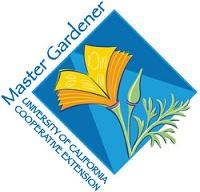
University of California
UC Master Gardener Program of Sonoma County
Conserve and Protect Water
There’s a catchy slogan about how to conserve water in the garden: “Slow it, spread it, sink it, store it.” How to conserve and protect water effectively in home gardens may seem a difficult undertaking, but it requires implementing only a few tasks. Conserving is paramount during a severe drought, but even in seemingly normal years, every drop counts.
Water Facts
- In Sonoma County, it is estimated that approximately 30,000 gallons of rainwater fall on a home rooftop each year. In most incorporated areas, that rain water goes, by design, directly into storm drains and out into the ocean.
- About half the water used in Sonoma County is drawn from reservoirs and half from natural aquifers below ground. Underground aquifers supply water for many types of private wells as well as for municipal water systems year-round, but especially during dry summer months.
- During times of drought, more water is drawn from wells causing local aquifers to drain faster than they are being recharged and, like others statewide, they are in danger of depletion.
- Approximately 50-70% of all residential water use occurs in the garden. That amount can be reduced by relying on low-water-requiring species and adjusting irrigation settings seasonally.
- Plants adjust to the number of daylight hours to determine water needs rather than only to temperature. Even though it is still hot in September, gardens needs only 60% of the water needed in July; in October, plants need only half that.
- New “smart” irrigation controllers or timers adjust run times based on time of year and locale. They can be hooked up to a sensor based on local weather conditions and automatically shut off if it rains. New controllers and timers save thousands of gallons of unneeded irrigation water.
Why Collect Rainwater
- Present practices are draining storage facilities and underground aquifers faster than they are being recharged; but it is possible to direct rain water from gardens and into the aquifers.
- Reducing runoff from rains into storm drains preserves fresh water for use rather than allowing it to merge with sea water.
- Home garden catchment systems channel runoff into containers for garden use or into natural storage areas that allow water to percolate into the aquifer.
Catchment Options
- Water catchment & reuse strategies focus on capturing rain water in barrels or tanks and then using that water for growing food crops and ornamentals in our summer-dry climate.
- Directing water into a designed rain garden holds it temporarily until it soaks into the ground. Runoff from any part of a property, including roofs, drains out of a rain garden within a day or two, filtering through soil before it enters the aquifer. During the dry season, a rain garden becomes an attractive landscape feature.
Protect water quality
- Avoid pesticides & herbicides in favor of employing IPM practices to prevent toxins from entering waterways.
- Avoid over fertilization by soil testing to understand a garden’s specific needs.
- Fertilize organically to support plants and the microbiotic community in the soil. Organic materials break down into nutrients used by plants as well as microbes.
Practical Water-Use Tips
- Replace water-hungry plants with drought-tolerant species appropriate to a summer-dry climate.
- Rely on shade-tolerant plants when possible; they require less frequent irrigation.
- Take into account every plant’s root depth, slope and elevation of planted areas, and soil type for optimal permeability .
- Mulch heavily to reduce evaporation and conserve water in the soil.
- Hydrozone by grouping plants with similar water needs and sun exposure. Water each zone with a separate valve if you have an automated irrigation controller or from separate hose bibs.
- Reduce evaporation by watering during cooler times of day, such as early morning.
- Use permeable patio and path materials such as stepping stones, pavers, decomposed granite, gravel, and organic mulch—all allow rainwater to be filtered as it is absorbed into the soil water and recharges underlying aquifers.
- Build berms (mounds), swales (valleys), and raingardens to spread rainwater, giving it time to percolate down and prevent erosion rather than runoff, taking topsoil with it.Eliminate ornamental turf. Its high-water use offers no ecological value to the local fauna and requires chemical inputs that run off into our waterways.
- Make every drop count by using drip irrigation that deposits water at a plant’s drip line and prevents waste. Plants then take up water from their feeder roots located at and beyond the drip line, the edge of the canopy of shrubs and trees.
Additional Information
- https://sonomamg.ucanr.edu/projects/Water-wise_Gardening/
- https://cagardenweb.ucanr.edu/Drought_/Drought_Irrigation_Tips_/
- https://sonomamg.ucanr.edu/files/122829.pdf (harvesting rainwater)
- https://ccuh.ucdavis.edu/tric (irrigating trees)
- https://earthzine.org/recharging-californias-diminishing-aquifers/
- https://anrcatalog.ucanr.edu/pdf/8531.pdf (rain garden)
- https://ucanr.edu/sites/scmg/files/122826.pdf (rain garden)







